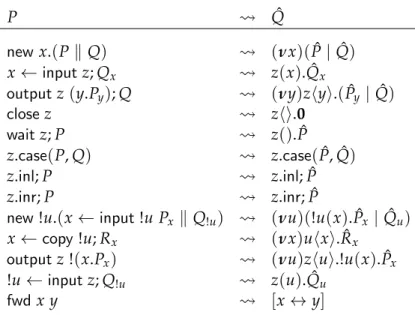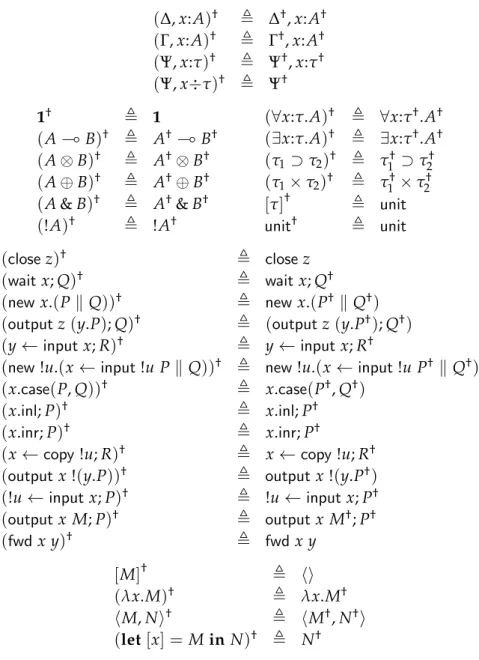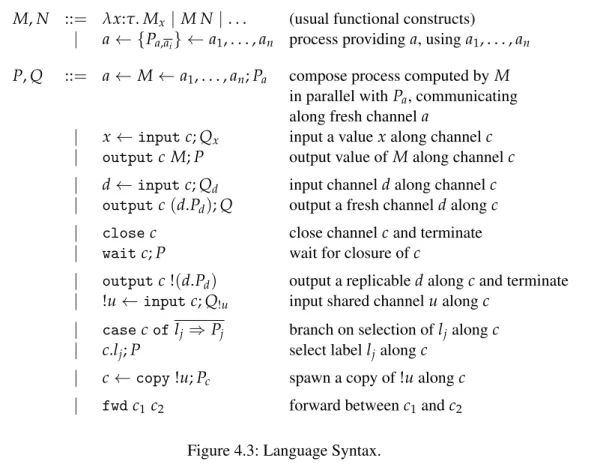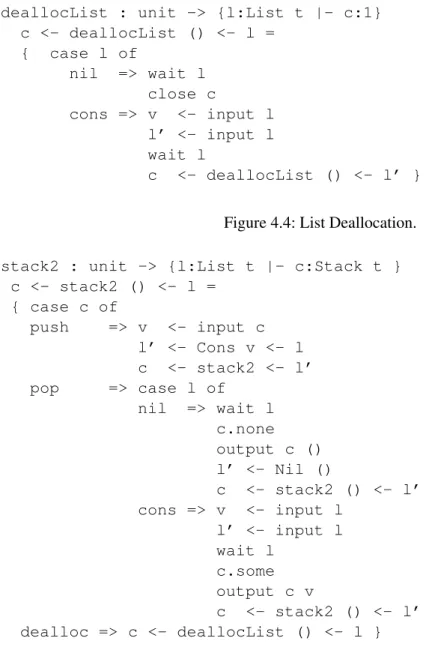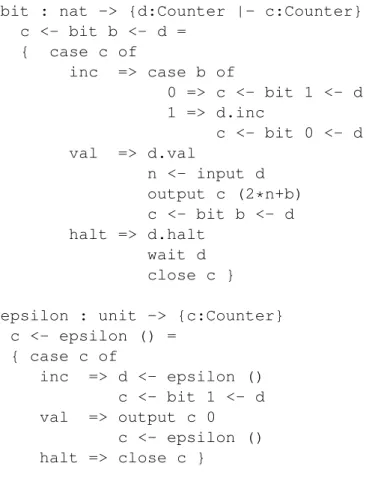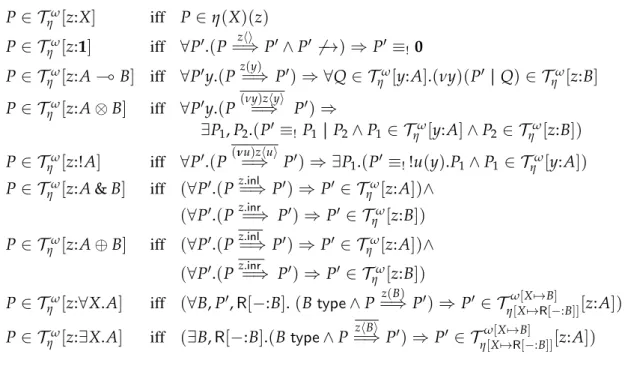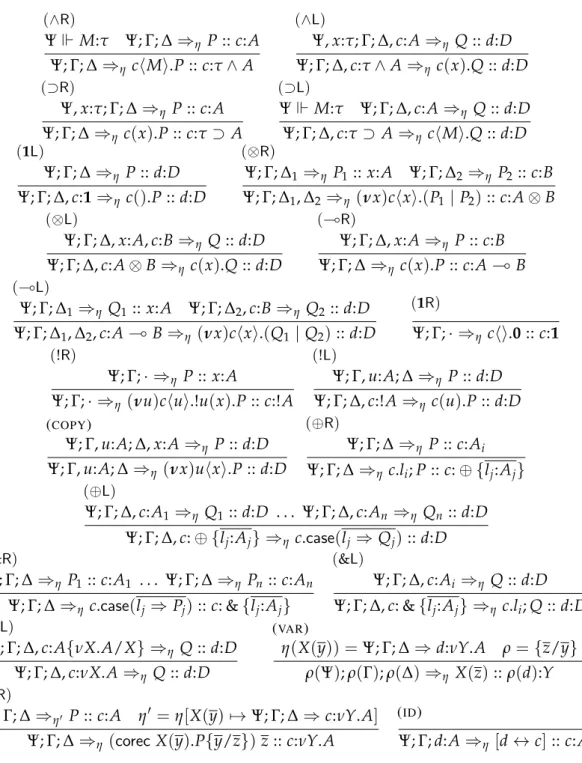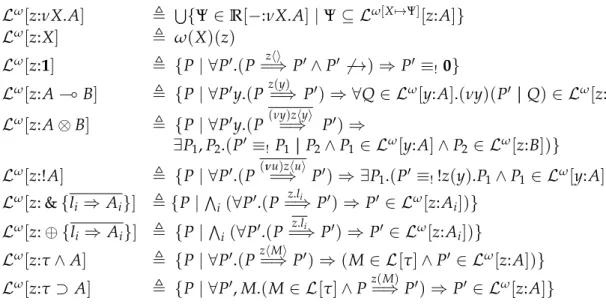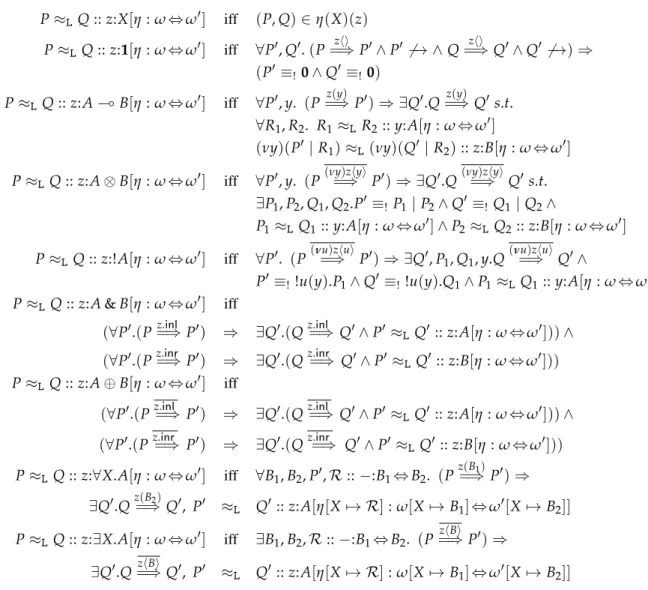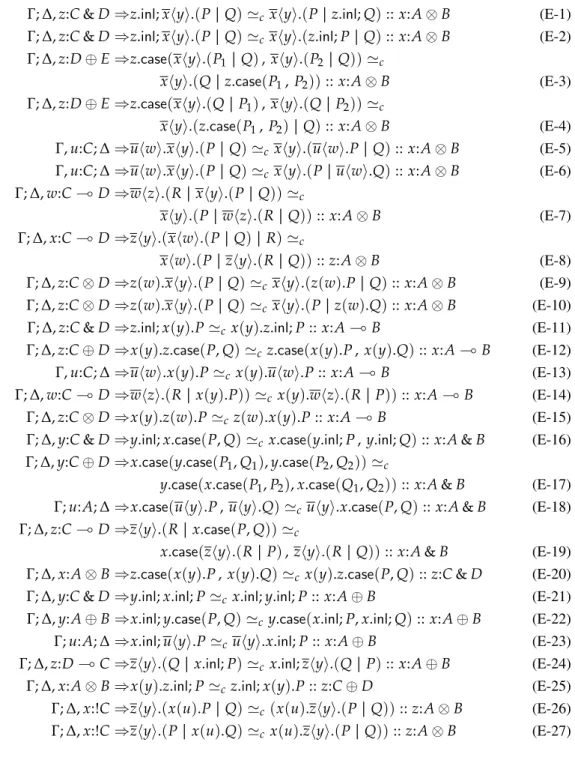B.Sc., M.Sc., Mestre em Engenharia Informática
A Logical Foundation for Session-based
Concurrent Computation
Dissertação para obtenção do Grau de Doutor em Engenharia Informática
Orientadores:
Frank Pfenning, Full Professor,
Carnegie Mellon University
Luís Caires, Prof. Catedrático,
Universidade Nova de Lisboa
Júri:
Presidente: Prof. António Ravara (Universidade Nova de Lisboa) Arguentes: Prof. Vasco Vasconcelos (Universidade de Lisboa)
Prof. Robert Harper (Carnegie Mellon University) Prof. Stephen Brookes (Carnegie Mellon University) Prof. Simon Gay (University of Glasgow)
Copyright cBernardo Parente Coutinho Fernandes Toninho, Faculdade de Ciências e Tecnologia, Universidade Nova de Lisboa
I’d like to first and foremost thank my advisors (in no particular order), Luís Caires and Frank Pfenning. They have both been incredible mentors throughout this several year-long journey and it has been an honor and a privilege working with them, starting with Luis’ classes on process calculi and Frank’s classes on proof theory, teaching me about these seemingly unrelated things that turned out not to be unrelated at all; all the way up to our collaborations, discussions and conversations over the years, without which the work presented in this document would have never been possible. I’d also like to thank my thesis committee, for their participation, availability and their precious feedback.
I’d like to thank the many people on both sides of the Atlantic for discussions, talks and feedback over the years, be it directly related to this work or not. Some honorable mentions, from the West to the East: Robert Simmons, Dan Licata, Chris Martens, Henry DeYoung, Carsten Schürmann, Beniamino Accattoli, Yuxin Deng, Ron Garcia, Jason Reed, Jorge Pérez, Hugo Vieira, Luísa Lourenço, Filipe Militão, everyone in the CMU POP and FCT PLASTIC groups. Moving to Pittsburgh was a tremendously positive experience where I learned a great deal about logic, programming languages, proof theory and just doing great research in general, be it through classes, projects or discussions that often resulted in large strings of greek letters and odd symbols written on the walls. Moving back to Lisbon was a welcomed reunion with colleagues, friends and family, to which I am deeply grateful.
I thank the great teachers that helped me grow academically from an undergraduate learning programming to a graduate student learning proof theory (it takes a long time to go back to where you started). I especially thank Nuno Preguiça, João Seco and Robert Harper for their unique and invaluable contributions to my academic education.
I am deeply fortunate to have an exceptional group of friends that embrace and accept the things that make me who I am: Frederico, Mário, Cátia, Filipe, Tiago, Luísa, Hélio, Sofia, Pablo, Kattis. Thanks guys (and girls)! I must also mention all the friends and acquaintances I’ve made by coming back to my hobby from 1997, Magic: The Gathering. It never ceases to amaze me how this game of chess with variance can bring so many different people together. May you always draw better than your opponents, unless your opponent is me, of course.
Linear logic has long been heralded for its potential of providing a logical basis for concurrency. While over the years many research attempts were made in this regard, a Curry-Howard corre-spondence between linear logic and concurrent computation was only found recently, bridging the proof theory of linear logic and session-typed process calculus. Building upon this work, we have developed a theory of intuitionistic linear logic as a logical foundation for session-based concurrent computation, exploring several concurrency related phenomena such as value-dependent session types and polymorphic sessions within our logical framework in an arguably clean and elegant way, establishing with relative ease strong typing guarantees due to the logical basis, which ensure the fundamental properties of type preservation and global progress, entailing the absence of deadlocks in communication.
We develop a general purpose concurrent programming language based on the logical interpre-tation, combining functional programming with a concurrent, session-based process layer through the form of a contextual monad, preserving our strong typing guarantees of type preservation and deadlock-freedom in the presence of general recursion and higher-order process communication.
We introduce a notion of linear logical relations for session typed concurrent processes, devel-oping an arguably uniform technique for reasoning about sophisticated properties of session-based concurrent computation such as termination or equivalence based on our logical approach, further supporting our goal of establishing intuitionistic linear logic as a logical foundation for session-based concurrency.
Por muito tempo a lógica linear tem sido denotada pelo seu potencial de fornecer uma base lógica à concorrência. Apesar de ao longo dos anos muitos esforços de investigação terem sido efectuados para este efeito, uma correspondência Curry-Howard entre a lógica linear e computação concorrente apenas foi descoberta recentemente, ligando a teoria de prova da lógica linear e cálculos de processos com tipos de sessão. Construindo sobre este trabalho, desenvolvemos uma teoria de lógica linear intuicionista como uma fundação lógica para computação concorrente baseada em sessões, explorando vários fenómenos da teoria da concorrência, como tipos de sessão com dependências de valor e sessões polimórficas, no nosso sistema de uma forma limpa e elegante, estabelecendo com facilidade técnica garantias fortes sobre os programas bem tipificados devido à base lógica, assegurando as propriedades fundamentais de preservação de tipos e progresso global, resultando na ausência de deadlocks durante comunicação.
Desenvolvemos uma linguagem de programação concorrente de uso geral, baseada na inter-pretação lógica, combinando programação funcional com uma camada de processos concorrentes baseada em sessões através de uma mónade contextual, preservando as fortes garantias de preser-vação de tipos e ausência de deadlocks na presença de recursão generalizada e comunicação de processos de ordem superior.
Introduzimos uma noção de relações lógicas lineares para processos concorrentes com tipos de sessão, desenvolvendo uma técnica uniforme para estudar propriedades sofisticadas de computação concorrente como terminação ou equivalência baseadas na nossa abordagem lógica, suportando assim o nosso objectivo de estabelecer a lógica linear intuicionista como uma fundação lógica para a concorrência baseada em sessões.
Palavras-chave: Lógica Linear, Tipos de Sessão, Curry-Howard, Concorrência,
Contents xiii
List of Figures xvii
1 Introduction 1
1.1 Modelling Message-Passing Concurrency . . . 2
1.2 π-calculus and Session Types . . . 5
1.3 Curry-Howard Correspondence . . . 6
1.4 Linear Logic and Concurrency . . . 7
1.5 Session-based Concurrency and Curry-Howard . . . 8
1.6 Contributions . . . 8
1.6.1 A Logical Foundation for Session-Based Concurrency . . . 8
1.6.2 Towards a Concurrent Programming Language . . . 10
1.6.3 Reasoning Techniques . . . 10
I A Logical Foundation for Session-based Concurrency 11 2 Linear Logic and Session Types 13 2.1 Linear Logic and the Judgmental Methodology . . . 13
2.2 Preliminaries . . . 16
2.2.1 Substructural Operational Semantics . . . 17
2.3 Propositional Linear Logic . . . 18
2.3.1 Judgmental Rules . . . 19
2.3.2 Multiplicatives . . . 20
2.3.3 Additives . . . 23
2.3.4 Exponential . . . 25
2.3.5 Examples . . . 27
2.4 Metatheoretical Properties . . . 29
2.4.1 Correspondence of process expressions andπ-calculus processes . . . . 30
2.4.2 Type Preservation . . . 33
2.4.3 Global Progress . . . 41
3 Beyond Propositional Linear Logic 47
3.1 First-Order Linear Logic and Value-Dependent Session Types . . . 48
3.1.1 Universal and Existential First-Order Quantification . . . 48
3.2 Example . . . 50
3.3 Metatheoretical Properties . . . 51
3.3.1 Correspondence between process expressions andπ-calculus processes . 52 3.3.2 Type Preservation . . . 53
3.3.3 Global Progress . . . 55
3.4 Value-Dependent Session Types – Proof Irrelevance and Affirmation . . . 55
3.4.1 Proof Irrelevance . . . 55
3.4.2 Affirmation . . . 57
3.5 Second-Order Linear Logic and Polymorphic Session Types . . . 60
3.5.1 Example . . . 62
3.6 Metatheoretical Properties . . . 62
3.6.1 Correspondence between process expressions andπ-calculus processes . 63 3.6.2 Type Preservation . . . 63
3.6.3 Global Progress . . . 64
3.7 Summary and Further Discussion . . . 65
II Towards a Concurrent Programming Language 67 4 Contextual Monadic Encapsulation of Concurrency 71 4.1 Typing and Language Syntax . . . 72
4.2 Recursion . . . 74
4.3 Examples . . . 78
4.3.1 Stacks . . . 78
4.3.2 A Binary Counter . . . 80
4.3.3 An App Store . . . 82
4.4 Connection to Higher-Orderπ-calculus . . . 83
4.5 Metatheoretical Properties . . . 84
4.5.1 Type Preservation . . . 84
4.5.2 Global Progress . . . 86
5 Reconciliation with Logic 87 5.0.3 Guardedness and Co-regular Recursion by Typing . . . 89
5.0.4 Coregular Recursion and Expressiveness - Revisiting the Binary Counter 90 5.1 Further Discussion . . . 93
III Reasoning Techniques 97
6.1 Unary Logical Relations . . . 101
6.1.1 Logical Predicate for Polymorphic Session Types . . . 104
6.1.2 Logical Predicate for Coinductive Session Types . . . 111
6.2 Binary Logical Relations . . . 122
6.2.1 Typed Barbed Congruence . . . 123
6.2.2 Logical Equivalence for Polymorphic Session Types . . . 127
6.2.3 Logical Equivalence for Coinductive Session Types . . . 132
6.3 Further Discussion . . . 136
7 Applications of Linear Logical Relations 139 7.1 Behavioral Equivalence . . . 139
7.1.1 Using Parametricity . . . 141
7.2 Session Type Isomorphisms . . . 142
7.3 Soundness of Proof Conversions . . . 144
7.4 Further Discussion . . . 150
8 Conclusion 153 8.1 Related Work . . . 154
8.2 Future Work . . . 156
Bibliography 159 A Proofs 165 A.1 Inversion Lemma . . . 165
A.2 Reduction Lemmas - Value Dependent Session Types . . . 170
A.3 Reduction Lemmas - Polymorphic Session Types . . . 171
A.4 Logical Predicate for Polymorphic Session Types . . . 172
A.4.1 Proof of Theorem 28 . . . 172
A.5 Proof Conversions . . . 173
1.1 π-calculus Syntax. . . 3
1.2 π-calculus Labeled Transition System. . . 4
1.3 Session Types . . . 5
2.1 Intuitionistic Linear Logic Propositions . . . 14
2.2 Translation from Process Expressions toπ-calculus Processes . . . 30
2.3 Process Expression Assignment for Intuitionistic Linear Logic . . . 45
2.4 Process Expression SSOS Rules . . . 46
3.1 A PDF Indexer . . . 52
3.2 Type-Directed Proof Erasure. . . 58
3.3 Type Isomorphisms for Erasure. . . 58
4.1 The Syntax of Types . . . 72
4.2 Typing Process Expressions and the Contextual Monad. . . 75
4.3 Language Syntax. . . 77
4.4 List Deallocation. . . 80
4.5 A Concurrent Stack Implementation. . . 80
4.6 A Bit Counter Network. . . 81
4.7 Monadic Composition as Cut . . . 83
6.1 π-calculus Labeled Transition System. . . 102
6.2 Logical predicate (base case). . . 107
6.3 Typing Rules for Higher-Order Processes . . . 114
6.4 Logical Predicate for Coinductive Session Types - Closed Processes . . . 115
6.5 Conditions for Contextual Type-Respecting Relations . . . 126
6.6 Logical Equivalence for Polymorphic Session Types (base case). . . 129
6.7 Logical Equivalence for Coinductive Session Types (base case) – abridged. . . 134
7.1 A sample of process equalities induced by proof conversions . . . 147
A.1 Process equalities induced by proof conversions: Classes (A) and (B) . . . 174
A.2 Process equalities induced by proof conversions: Class (C) . . . 175
C
H
A
P
T
1
I
NTRODUCTION
Over the years, computation systems have evolved from monolithic single-threaded machines to concurrent and distributed environments with multiple communicating threads of execution, for which writing correct programs becomes substantially harder than in the more traditional sequential setting. These difficulties arise as a result of several issues, fundamental to the nature of concurrent and distributed programming, such as: the many possibleinterleavings of executions, making programs hard to test and debug;resource management, since often concurrent programs must interact with (local or remote) resources in an orderly fashion, which inherently introduce constraints in the level of concurrency and parallelism a program can have; andcoordination, since the multiple execution flows are intended to work together to produce some ultimate goal or result, and therefore must proceed in a coordinated effort.
Concurrency theory often tackles these challenges through abstract language-based models of concurrency, such as process calculi, which allow for reasoning about concurrent computation in a precise way, enabling the study of the behavior and interactions of complex concurrent systems. Much like the history of research surrounding theλ-calculus, a significant research effort has been made to develop type systems for concurrent calculi (the most pervasive being theπ-calculus) that, by disciplining concurrency, impose desirable properties on well-typed programs such as deadlock-freedom or absence of race conditions.
However, unlike the (typed) λ-calculus which has historically been known to have a deep connection with intuitionistic logic, commonly known as the Curry-Howard correspondence, no equivalent connection was established between theπ-calculus and logic until quite recently. One may then wonder why is such a connection important, given that process calculi have been studied since the early 1980s, with theπ-calculus being established as thelingua francaof interleaving concurrency calculi in the early 1990s, and given the extensive body of work that has been developed based on these calculi, despite the lack of foundations based on logic.
it with proof theory and logic. Pragmatically, a logical foundation opens up the possibility of employing established techniques from logic to the field of concurrency theory, potentially providing elegant new means of reasoning and representing concurrent phenomena, which in turn enable the development of techniques to ensure stronger correctness and reliability of concurrent software. Fundamentally, a logical foundation allows for a compositional and incremental study of new language features, since the grounding in logic ensures that such extensions do not harm previously obtained results. This dissertation seeks to support the following:
Thesis Statement: Linear logic, specifically in its intuitionistic formulation, is a suitable
logical foundation for message-passing concurrent computation, providing an elegant framework in which to express and reason about a multitude of naturally occurring phenomena in such a concurrent setting.
1.1
Modelling Message-Passing Concurrency
Concurrency is often divided into two large models: shared-memory concurrency and message-passing concurrency. The former enables communication between concurrent entities through modification of memory locations that are shared between the entities; whereas in the latter the various concurrently executing components communicate by exchanging messages, either synchronously or asynchronously.
Understanding and reasoning about concurrency is ongoing work in the research community. In particular, many language based techniques have been developed over the years for both models of concurrency. For shared-memory concurrency, the premier techniques are those related to (concurrent) separation logic [56], which enables formal reasoning about memory configurations that may be shared between multiple entities. For message-passing concurrency, which is the focus of this work, the most well developed and studied techniques are arguably those ofprocess calculi [19, 68]. Process calculi are a family of formal language that enable the precise description of concurrent systems, dubbedprocesses, by modelling interaction through communication across an abstract notion of communication channels. An important and appealing feature of process calculi is their mathematical and algebraic nature: processes can be manipulated via certain algebraic laws, which also enable formal reasoning about processbehavior[50, 70, 71].
While many such calculi have been developed over the years, thede factostandard process calculus is arguably theπ-calculus [52, 68], a language that allows modelling of concurrent systems that communicate over channels that may themselves be generated dynamically and passed in communication. Typically, theπ-calculus also includes replication (i.e. the ability to spawn an arbitrary number of parallel copies of a process), which combined with channel generation and passing makes the language a Turing complete model of concurrent, message-passing computation. Many variants of theπ-calculus have been developed in the literature (a comprehensive study can be found in [68]), tailored to the study of specific features such as asynchronous communication, higher-order process communication [53], security protocol modelling [1], among many others.
P ::= 0 | P|Q | (νy)P | xhyi.P | x(y).P
!x(y).P | [x↔y] | x.inl;P | x.inr;P | x.case(P,Q)
Figure 1.1:π-calculus Syntax.
forwarder[x↔y]reminiscent of the forwarders used in the internal mobilityπ-calculus [67], or explicit fusions of [57]). The so-called static fragment of theπ-calculus consists of the inactive process0; the parallel composition operatorP |Q, which composes in parallel processesPand Q; and the scope restriction(νy)P, binding channelyinP. The communication primitives are the output and input prefixed processes,xhyi.P, which sends channelyalongxandx(y).Pwhich inputs alongxand binds the received channel toyinP. We restrict general unbounded replication to an input-guarded form!x(y).P, denoting a process that waits for inputs onxand subsequently spawns a replica ofPwhen such an input takes place. The channel forwarding construct[x↔y] equates the two channel namesxandy. We also consider (binary) guarded choicex.case(P,Q) and the two corresponding selection constructsx.inl;P, which selects the left branch, andx.inr;P, which selects the right branch.
For any processP, we denote the set of free namesof Pbyfn(P). A process isclosedif it does not contain free occurrences of names. We identify processes up to consistent renaming of bound names, writing≡α for this congruence. We writeP{x/y}for the process obtained fromP by capture avoiding substitution ofxforyinP.
The operational semantics of theπ-calculus are usually presented in two forms: reduction semantics, which describe how processes react internally; and labelled transition semantics, which specify how processes may interact with their environment. Both semantics are defined up-to a con-gruence≡which expresses basic structural identities of processes, dubbedstructural congruence.
Definition 1(Structural Congruence). Structural congruence(P ≡ Q), is the least congruence
relation on processes such that
P|0≡ P (S0) P≡α Q⇒ P≡Q (Sα) P|Q≡Q| P (S|C) P|(Q| R)≡(P| Q)|R (S|A) (νx)0≡0 (Sν0) x6∈fn(P)⇒P| (νx)Q≡(νx)(P| Q) (Sν|) (νx)(νy)P≡ (νy)(νx)P (Sνν) [x↔y]≡[y↔x] (S↔)
Definition 2(Reduction). Reduction(P→Q), is the binary relation on processes defined by:
P→α Q (νy)P→α (νy)Q
(res) P α
→Q
P| R→α Q| R(par)
P→α P′ Q→α Q′ P|Q→τ P′ |Q′ (com)
P(νy→)xhyiP′ Qx→(y)Q′ P|Q→τ (νy)(P′ |Q′)
(close) P xhyi
→ Q
(νy)P
(νy)xhyi
→ Q
(open) xhyi.Px→hyiP(out)
x(y).Px→(z)P{z/y}(in) !x(y).Px→(z)P{z/y}| !x(y).P(rep) x.inl;Px→.inlP(lout) x.inr;Px→.inrP(rout) x.case(P,Q)x→.inlP(lin) x.case(P,Q)x→.inrQ(rin)
(νx)(P|[x↔y])→τ P{y/x}(link)
Figure 1.2:π-calculus Labeled Transition System.
We adopt the so-called early transition system for the π-calculus [68] extended with the appropriate labels and transition rules for the choice constructs. A transitionP→α Qdenotes that processPmay evolve to processQby performing the action represented by the labelα. Transition labels are given by
α::= xhyi | x(y)|(νy)xhyi | x.inl |x.inr |x.inl |x.inr |τ
Actions are inputx(y), the left/right offersx.inlandx.inr, and their matching co-actions, respec-tively the outputxhyiand bound output(νy)xhyiactions, and the left/ right selectionsx.inland x.inr. The bound output(νy)xhyidenotes extrusion of a fresh nameyalong (channel)x. Internal action is denoted byτ. In general an actionα(α) requires a matchingα(α) in the environment to enable progress, as specified by the transition rules. For a labelα, we define the setsfn(α)and bn(α)of free and bound names, respectively, as follows: inxhyiandx(y)bothxandyare free; in x.inl,x.inr,x.inl, andx.inr,xis free; in(νy)xhyi,xis free andyis bound. We denote bys(α) the subject ofα(e.g.,xinxhyi).
Definition 3(Labeled Transition System). The relationlabeled transition(P→α Q) is defined by
the rules in Figure 6.1, subject to the side conditions: in rule(res), we requirey 6∈fn(α); in rule (par), we require bn(α)∩fn(R) =∅; in rule (close), we requirey6∈ fn(Q); in rule(link), we requirex6=y. We omit the symmetric versions of rules(par),(com),(close)and(link).
We can make precise the relation between reduction andτ-labeled transition [68], and closure of labeled transitions under≡as follows. We writeρ1ρ2for relation composition (e.g.,→≡τ ).
Proposition 1.
A,B,C ::= A⊸B input channel of typeAand continue asB | A⊗B output fresh channel of typeAand continue asB | 1 terminate
| A&B offer choice betweenAandB | A⊕B provide eitherAorB
| !A provide replicable session of typeA
Figure 1.3: Session Types
As in the history of theλ-calculus, many type systems for theπ-calculus have been developed over the years. The goal of these type systems is to discipline communication in some way as to avoid certain kinds of errors. While the early type systems for theπ-calculus focused on assigning types to values communicated on channels (e.g. the type of channelcstates that only integers can be communicated alongc), and on assigning input and output capabilities to channels (e.g. process Pcan only send integers on channelcand processQcan only receive), arguably the most important family of type systems developed for theπ-calculus aresession types.
1.2
π
-calculus and Session Types
The core idea of session types is to structure communication between processes around the concept of asession. A (binary) session consists of a description of the interactive behavior between two components of a concurrent system, with an intrinsic notion of duality: When one component sends, the other receives; when one component offers a choice, the other chooses. Another crucial point is that a session is stateful insofar as it is meant to evolve over time (e.g. “input an integer and afterwards output a string”) until all its codified behavior is carried out. A sessiontype[41, 43] codifies the intended session that must take place over a given communication channel at the type level, equating type checking with a high-level form of communication protocol compliance checking.
The communication idioms that are typically captured in session types are input and output behavior, choice and selection, replication and recursive behavior. It is also common for session type systems to have a form ofsession delegation(i.e. delegating a session to another process via communication). Moreover, session types can provide additional guarantees on system behavior than just adhering to the ascribed sessions, such asdeadlock absenceandliveness[26]. We present a syntax for session types in Fig. 1.3, as well as the intended meaning of each type constructor. We use a slightly different syntax than that of the original literature on session types [41, 43], which conveniently matches the syntax of propositions in (intuitionistic) linear logic. We make this connection precise in Chapters 2 and 3.
the behavioral theory (in the sense of behavioral equivalence) of session typed systems is also quite intricate, requiring sophisticated bisimilarities which are hard to reason about, and from a technical standpoint, for which establishing the desirable property of contextuality or congruence (i.e. equivalence in any context) is a challenging endeavour.
1.3
Curry-Howard Correspondence
At the beginning of Chapter 1 we mentioneden passantthe connection of typedλ-calculus and intuitionistic logic, commonly known as the Curry-Howard correspondence, and the historical lack of such a connection between theπ-calculus and logic (until the recent work of [16]). For the sake of completeness, we briefly detail the key idea behind this correspondence and its significance.
The Curry-Howard correspondence consists of an identification between formal proof calculi and type systems for models of computation. Historically, this connection was first identified by Haskell Curry [23] and William Howard [44]. The former [23] observed that the types of the combinators of combinatory logic corresponded to the axiom schemes of Hilbert-style deduction systems for implication. The latter [44] observed that the proof system known as natural deduction for implicational intuitionistic logic could be directly interpreted as a typed variant of theλ-calculus, identifying implication with the simply-typedλ-calculus’ arrow type and the dynamics of proof simplification with evaluation ofλ-terms.
While we refrain from the full technical details of this correspondence, the key insight is the idea of identifying proofs in logic as programs in theλ-calculus, and vice-versa, thus giving rise to the fundamental concepts of proofs-as-programs and programs-as-proofs (a somewhat comprehensive survey can be found in [82]). The basic correspondence identified by Curry and Howard enabled the development of a new class of formal systems designed to act as both a proof system and as a typed programming language, such as Martin-Löf’s intuitionistic type theory [49] and Coquand’s Calculus of Constructions [22].
Moreover, the basis of this interpretation has been shown to scale well beyond the identification of implication and the function type of theλ-calculus, enabling an entire body of research devoted to identifying thecomputational meaningof extensions to systems of natural deduction such as Girard’s System F [35] as a language of second-order propositional logic; modal necessity and possibility as staged computation [24] and monadic types for effects [80], among others. Dually, it also becomes possible to identify thelogical meaningof computational phenomena.
1.4
Linear Logic and Concurrency
In the concurrency theory community, linearity has played a key role in the development of typing systems for theπ-calculus. Linearity was used in early type systems for theπ-calculus [47] as a way of ensuring certain desirable properties. Ideas from linear logic also played a key role in the development of session types, as acknowledged by Honda [41, 43].
Girard’s linear logic [36] arises as an effort to marry the dualities of classical logic and the constructive nature of intuitionistic logic by rejecting the so-called structural laws of weakening (“I need not use all assumptions in a proof”) and contraction (“If I assume something, I can use it multiple times”). Proof theoretically, this simple restriction turns out to have profound consequences in the meaning of logical connectives. Moreover, the resulting logic is one where assumptions are no longer persistent immutable objects but rather resources that interact, transform and are consumed during inference. Linear logic divides conjunction into two forms, which in linear logic terminology are called additive (usually dubbed “with”, written&) and multiplicative (dubbed “tensor”, and written⊗), depending on how resources are used to prove the conjunction. Additive conjunction denotes a pair of resources where one must choose which of the elements of the pair one will use, although the available resources must be able to realize (i.e. prove) both elements. Multiplicative conjunction denotes a pair of resources where both resourcesmustbe used, since the available resources simultaneously realize both elements and all resources must be consumed in a valid inference (due to the absence of weakening and contraction). In classical linear logic there is also a similar separation in disjunction, while in the intuitionistic setting we only have additive disjunction⊕which denotes an alternative between two resources (we defer from a precise formulation of linear logic for now).
The idea of propositions as mutable resources that evolve independently over the course of logical inference sparked interest in using linear logic as a logic of concurrent computation. This idea was first explored in the work of Abramsky et. al [3], which developed a computational interpretation of linear logic proofs, identifying them with programs in a linearλ-calculus with parallel composition. In his work, Abramsky gives a faithful proof term assignment to classical linear logic sequent calculus, identifying proof composition with parallel composition. This proofs-as-processes interpretation was further refined by Bellin and Scott [8], which mapped classical linear logic proofs to processes in the synchronous π-calculus with prefix commutation as a structural process identity. Similar efforts were developed more recently in [42], connecting polarised proof-nets with an (I/O) typed π-calculus, and in [28] which develops ludics as a model for the finitary linearπ-calculus. However, none of these interpretations provided a true Curry-Howard correspondence insofar as they either did not identify a type system for which linear logic propositions served as type constructors (lacking the propositions-as-types part of the correspondence); or develop a connection with only a very particular formulation of linear logic (such as polarised proof-nets).
was made precise. The work of [16] develops a Curry-Howard correspondence between session types andintuitionisticlinear logic, identifying (typed) processes with proofs, session types with linear logic propositions and process reduction with proof reduction. Following the discovery in the context of intuitionistic linear logic, classical versions of this correspondence have also been described [18, 81].
1.5
Session-based Concurrency and Curry-Howard
While we have briefly mentioned some of the conceptual benefits of a correspondence in the style of Curry-Howard for session-based concurrency in the previous sections, it is important to also emphasize some of the more pragmatic considerations that can result from the exploration and development of such a correspondence, going beyond the more foundational or theoretical benefits that follow from a robust logical foundation for concurrent calculi.
The identification of computation with proof reduction inherently bestows upon computation the good theoretical properties of proof reduction. Crucially, as discussed in [16], it enables a very natural and clean account of a form of global progressfor session-typed concurrent processes, entailing the absence ofdeadlocks– “communication never gets stuck” – in typed communication protocols. Additionally, logical soundness entails that proof reduction is a finite procedure, which in turn enables us to potentially ensure that typed communication is not onlydeadlock-freebut also terminating, a historically challenging property to establish in the literature.
Moreover, as the logical foundation scales beyond simple (session) types to account for more advanced typing disciplines such as polymorphism and coinductive types (mirroring the develop-ments of Curry-Howard for functional calculi), we are expected to preserve such key properties, enabling the development of session-based concurrent programming languages where deadlocks are excluded as part of the typing discipline, even in the presence of sophisticated features such as mobile or polymorphic code.
1.6
Contributions
The three parts of this dissertation aim to support three fundamental aspects of our central thesis of using linear logic as a logical foundation for message-passing concurrent computation: (1) the development and usage of linear logic as a logical foundation for session-based concurrency, able to account for multiple relevant concurrency-theoretic phenomena; (2) the ability of using the logical interpretation as the basis for a concurrent programming language that cleanly integrates functional and session-based concurrent programming; and (3), developing effective techniques for reasoning about concurrent programs based on this logical foundation.
1.6.1 A Logical Foundation for Session-Based Concurrency
dissertation as a basis to explain and justify phenomena that arise naturally in message-passing concurrency, developing the idea of using linear logic as a logical foundation for message-passing concurrent computation in general. The second major contribution is the scaling of the interpretation of [16] beyond the confines of simple session types (and even theπ-calculus), being able to also account for richer and more sophisticated phenomena such as dependent session types [75] and parametric polymorphism [17], all the while doing so in a technically elegant way and preserving the fundamental type safety properties ofsession fidelityandglobal progress, ensuring the safety of typed communication disciplines. While claims of elegance are by their very nature subjective, we believe it is possible to support these claims by showing how naturally and easily the interpretation can account for these phenomena that traditionally require quite intricate technical developments.
More precisely, in Chapter 2 we develop the interpretation of linear logic as session types that serves as the basis for the dissertation. The interpretation diverges from that of [16] in that it does not commit to theπ-calculusa priori, developing a proof term assignment that can be used as a language for session-typed communication, but also maintaining its connections to the
π-calculus. The goal of this “dual” development, amongst other technical considerations, is to further emphasize that the connection of linear logic and session-typed concurrency goes beyond that of having aπ-calculus syntax and semantics. While we may use theπ-calculus assignment when it is convenient to do so (and in fact we do precisely this in Part III), we are not necessarily tied to theπ-calculus. This adds additional flexibility to the interpretation since it enables a form of “back and forth” reasoning between π-calculus and the faithful proof term assignment that is quite natural in proofs-as-programs approaches. We make the connections between the two term assignments precise in Section 2.4.1, as well as develop the metatheory for our assignment (Section 2.4), establishing properties of type preservation and global progress.
In Chapter 3 we show how to scale the interpretation to account for more sophisticated con-current phenomena by developing the concepts of value dependent session types (Section 3.1) and parametric polymorphism (Section 3.5) as they arise by considering first and second-order intuitionistic linear logic, respectively. These are natural extensions to the interpretation that provide a previously unattainable degree of expressiveness within a uniform framework. Moreover, the logical nature of the development ensures that type preservation and global progress uniformly extend to these richer settings.
1.6.2 Towards a Concurrent Programming Language
A logical foundation must also provide the means of expressing concurrent computation in a natural way that preserves the good properties one obtains from logic. We defend this idea in Part II of the dissertation by developing the basis of a concurrent programming language that combines functional and session-based concurrent programs via a monadic embedding of session-typed process expressions in aλ-calculus (Chapter 4). One interesting consequence of this embedding is that it allows for process expressions to send, receive and executeotherprocess expressions (Section 4.4), in the sense ofhigher-order processes [68], preserving the property of deadlock-freedom by typing (Section 4.5), a key open problem before this work.
For practicality and expressiveness, we consider the addition of general recursive types to the language (Section 4.2), breaking the connection with logic in that it introduces potentially divergent computations, but enabling us to showcase a wider range of interesting programs. To recover the connections with logic, in Chapter 5 we restrict general recursive types to coinductive session types, informally arguing for non-divergence of computation through the introduction of syntactic restrictions on recursive process definitions (the formal argument is developed in Part III), similar to those used in dependently typed programming languages with recursion such as Coq [74] and Agda [55], but with additional subtleties due to the concurrent nature of the language.
1.6.3 Reasoning Techniques
Another fundamental strength of a logical foundation for concurrent computation lies in its capacity to provide both the ability to express and also reason about such computations. To this end, we develop in Part III of the dissertation a theory oflinear logical relationson theπ-calculus assignment for the interpretation (Chapter 6), developing both unary (Section 6.1) and binary (Section 6.2) relations for the polymorphic and coinductive settings, which consists of a restricted form of the language of Chapter 4, following the principles of Chapter 5. We show how these relations can be applied to develop interesting results such as termination of well-typed processes in the considered settings, and concepts such as a notion of logical equivalence.
A Logical Foundation for Session-based
C
H
A
P
T
2
L
INEAR
L
OGIC AND
S
ESSION
T
YPES
In this chapter, we develop the connections of propositional linear logic and session types, develop-ing a concurrent proof term assignment to linear logic proofs that corresponds to a session-typed
π-calculus. We begin with a brief introduction of the formalism of linear logic and the judgmental methodology used throughout this dissertation. We also introduce the concept ofsubstructural operational semantics[62] which we use to give a semantics to our proof term assignment and later (Part II) to our programming language.
The main goal of this chapter is to develop and motivate the basis of the logical foundation for session-typed concurrent computation. To this end, our development of a concurrent proof term assignment for intuitionistic linear logic does not directly useπ-calculus terms (as the work of [16]) but rather a fully syntax driven term assignment, faithfully matching the dynamics of proofs, all the while being consistent with the originalπ-calculus assignment. The specifics and the reasoning behind this new assignment are detailed in Section 2.2. The term assignment is developed incrementally in Section 2.3, with a full summary in Section 2.5 for reference. Some examples are discussed in Section 2.3.5. Finally, we establish the fundamental metatheoretical properties of our development in Section 2.4. Specifically, we make precise the correspondence between our term assignment and theπ-calculus assignment and establish type preservation and global progress results, entailing a notion of session fidelity and deadlock-freedom.
2.1
Linear Logic and the Judgmental Methodology
In Section 1.4 we gave an informal description of the key ideas of linear logic and its connections to session-based concurrency. Here, we make the formalism of linear logic precise so that we may then carry out our concurrent term assignment to the rules of intuitionistic linear logic.
A,B,C ::= 1| A⊸B| A⊗B| A&B| A⊕B|!A
Figure 2.1: Intuitionistic Linear Logic Propositions
resourcesthat evolve, interact and are consumed during logical inference. Thus, linear logic treats evidence asephemeralresources – using a resource consumes it, making it unavailable for further use. While linear logic can be presented in both classical and intuitionistic form, we opt for the intuitionistic formalism since it has a more natural correspondence with our intuition of resources and resource usage. Moreover, as we will see later on (Part II), intuitionistic linear logic seems to be more amenable to integration in aλ-calculus based functional language (itself connected to intuitionistic logic).
Seeing as linear logic is a logic of resources and their usage disciplines, linear logicpropositions can be seen as resource combinators that specify how certain kinds of resources are meant to be used. Propositions (referred to by A,B,C – Fig. 2.1) in linear logic can be divided into three categories, depending on the discipline they impose on resource usage: themultiplicativefragment, containing1, A⊗Band A⊸ B; theadditivefragment, containing A&Band A⊕B; and the exponentialfragment, containing!A. The multiplicative unit1 is the distinguished proposition which denotes no information – no resources are used to provide this resource. Linear implication A⊸Bdenotes a form of resource transformation, where a resourceAis transformed into resource B. Multiplicative conjunction A⊗B encodes simultaneous availability of resources Aand B. Additive conjunctionA&Bdenotes the alternative availability ofAandB(i.e., each is available but not both simultaneously). Additive disjunction A⊕Bdenotes the availability either AorB (i.e., only one is made available). Finally, the exponential!Aencodes the availability of an arbitrary number of instances of the resource A.
Our presentation of linear logic consists of asequent calculus, corresponding closely to Barber’s dual intuitionistic linear logic [7], but also to Chang et al.’s judgmental analysis of intuitionistic linear logic [21]. Our main judgment is written∆⊢ A, where∆is a multiset of (linear) resources that are fully consumed to offer resourceA. We write·for the empty context. Following [21], the exponential!Ainternalizes validity in the logic – proofs ofAusing no linear resources, requiring an additional context of unrestricted or exponential resourcesΓand the generalization of the judgment toΓ;∆⊢ A, where the resources inΓneed not be used.
proof systems include cut and identity rules (and also explicit exchange, weakening and contraction rules as needed), which cana posteriorishown to be redundant via cut elimination and identity expansion. Alternatively (as in [21]), cut and identity may be omitted from the proof system and then shown as admissible principles of proof. We opt for the former since we wish to be able to express composition as primitive in the framework and reason explicitly about the computational content of proofs as defined by their dynamics during the cut elimination procedure.
To fully account for the exponential in our judgmental style of presentation, beyond the additional context regionΓ, we also require two additional rules: an exponential cut principle, which specifies how to compose proofs that manipulate persistent resources; and acopyrule, which specifies how to use a persistent resource.
The rules of linear logic are presented in full detail in Section 2.3, where we develop the session-based concurrent term assignment to linear logic proofs and its correspondence to π-calculus processes. The major guiding principle for this assignment is the computational reading of the cut elimination procedure, which simplifies the composition of two proofs to a composition of smaller proofs. At the level of the proof term assignment, this simplification or reduction procedure serves as the main guiding principle for the operational semantics of terms (and of processes).
As a way of crystallizing the resource interpretation of linear logic and its potential for a session-based concurrent interpretation, consider the following valid linear judgmentA⊸B,B⊸
C,A ⊢ C. According to the informal description above, the linear implication A ⊸ B can be seen as a form of resource transformation: provide it with a resourceAto produce a resourceB. Given this reading, it is relatively easy to see why the judgment is valid: we wish to provide the resourceCby making full use of resources A⊸B,B⊸CandA. To do this, we use the resource Ain combination with the linear implicationA⊸B, consuming the Aand producingB, which we then provide to the implicationB⊸Cto finally obtainC. While this resource manipulation reading of inference seems reasonable, where does the session-based concurrency come from? The key intuition consists of viewing a proposition as a denotation of the state of aninteractive behavior(a session), and that such a behavior is resource-like, where we can view the interplay of the various interactive behaviors asconcurrent interactionsspecified by the logical meaning of the propositional connectives. Thus, appealing to this session-based reading of linear logic propositions, A⊸Bstands for the type of an object that implements the interaction of receiving a behaviorA to then produce the behaviorB.
From a session-based concurrent point of view, we may interpret the judgment A⊸B,B⊸ C,A ⊢ Cas follows: in an environment composed of three independent interactive behaviors offered by, say,P,QandR, wherePprovides a behavior of type A⊸B,Qone of typeB⊸C andRone of type A, we can make use of these interactive behaviors to provide a behaviorC. As will see later on, the realizer for this behaviorCmust therefore consist of plugging togetherRand Pby sendingPsome information, after whichSwill be able to connectPwithQto obtainC.
Foreshadowing our future developments, we can extract from the inference of A⊸B,B⊸
stage in the presentation:
x:A⊸B,y:B⊸C,z:A⊢ S::w:C where S=output x z;outputy x;outputw y The code forScaptures the intuition behind the expected behavior of the process that transforms the available behaviors into an offer ofC. It begins by linkingzwithx, sending the former alongx. We are now in a setting wherexis offeringBand thus we send it toywhich ultimately results in theCwe were seeking. Moreover, provided with the appropriate processesP,QandR(extractable from linear logic proofs), we can account for the closed concurrent system made up of the four processes executing concurrently (again, modulo some syntactic conveniences):
⊢new x,y,z.(PkQkRkS)::w:C where
⊢ P::x:A⊸B ⊢ Q::y:B⊸C ⊢ R::z:A
As will be made clear throughout our presentation, this rather simple and arguably intuitive reading of linear logic turns out to provide an incredibly rich and flexible framework for defining and reasoning about session-based, message-passing programs.
2.2
Preliminaries
In this section we present some introductory remarks that are crucial for the full development of the logical interpretation of Section 2.3.
convenient, and abandoning theπ-calculus outright would diminish the claims of providing a true logical foundation of session-based concurrent computation.
In our presentation we develop the proof term assignmentin tandemwith theπ-calculus term assignment but without placing added emphasis on one or the other, enabling reasoning with techniques from proof theory and process calculi (and as we will see, combinations of both) and further emphasizing the back-and-forth from language to logic that pervades the works exploring logical correspondences in the sense of Curry-Howard. The presentation also explores the idea of identifying a process by the channel along which it offers its session behavior. This concept is quite important from a language design perspective (since it defines precise boundaries on the notion of a process), but is harder to justify in theπ-calculus assignment. The identification of processes by a single channel further justifies the use of intuitionistic linear logic over classical linear logic, for which a correspondence with session types may also be developed (viz. [18, 81]), but where the classical nature of the system makes such an identification rather non-obvious.
2.2.1 Substructural Operational Semantics
As mentioned above, we define the operational semantics of process expressions in the form of asubstructural operational semantics(SSOS) [62]. For the reader unfamiliar with this style of presentation, it consists of a compositional specification of the operational semantics by defining a predicate on the expressions of the language, through rules akin to those of multiset rewriting [20], where the pattern to the left of the⊸arrow (not to be confused with our object language usage of⊸as a type) describes a state which is consumed and transformed into the one to the right. The pattern on the right is typically made up of several predicates, which are grouped using a⊗. The SSOS framework allows us to generate fresh names through existential quantification and crucially does not require an explicit formulation of structural congruence, as one would expect when defining the typical operational semantics for process calculi-like languages. This is due to the fact that the metatheory of SSOS is based on ordered logic programming where exchange is implicit for the linear fragment of the theory. In the remainder of this document we only make use of the linear fragment of SSOS.
To exemplify, we develop a simple SSOS specification of a destination-passing semantics for a linearλ-calculus using three linear predicates:eval M dwhich denotes aλ-termMthat is to be evaluated on destinationd;return V d, denoting the return of valueV to destinationd; and contx F w, which waits on a value from destinationxto carry outFand pass the result tow. Fresh destinations can be generated through existential quantification.
To evaluate function application M Nwe immediately start the evaluation of M to a fresh destinationxand generate a continuation which waits for the evaluation ofMbefore proceeding:
eval(M N)d⊸{∃x.evalM x⊗contx(_N)d}
Sinceλ-expressions do not trigger evaluation, they are returned as values:
When a returned function meets its continuation, we may evaluate its body by instantiating the destination of the argument accordingly:
return(λy.M)d⊗contx (_N)w⊸{∃z.eval(M{z/y})w⊗evalN z}
When we encounter a variable we have to wait for its value, forwarding it to the target destination: evalx w⊸{contx_w}
Finally, when a continuation waits for the return of a value, we return it on the destination of the continuation:
returnv x⊗contx_w⊸{returnv w}
It is straightforward to see how these five rules combined define a rewriting system for evaluating linearλ-calculus terms using destinations (more examples can be found in [62], making full use of the ordered nature of the framework). We note that the operational semantics specified above are identical to futures, in the sense that evaluation of a function body and its argument can proceed in parallel.
To develop the SSOS for our language of process expressions we rely on the following two predicates (these will be extended further as we proceed in the presentation): the linear proposition execPdenotes the state of a linear process expressionPand!execPdenotes the state of a persistent process (which must always be a replicating input).
We useΩ−→Ω′to refer to a single multiset rewriting, according to the specified SSOS rules, from execution stateΩto execution stateΩ′. As usual, we use−→+and−→∗for the transitive and reflexive transitive closures of−→. We write−→nto denote a sequence ofnrewrite steps and
−→n,m to denote a sequence ofnormrewrite steps.
2.3
Propositional Linear Logic
We now develop our concurrent interpretation of intuitionistic linear logic, going through each sequent calculus rule and giving it both a π-calculus and a corresponding process expression assignment. For the rules of linear logic and our process expression assignment we employ the judgment Γ;∆ ⊢ A andΓ;∆ ⊢ P :: z:A, respectively, whereas for theπ-calculus assignment we use the judgmentΓ;∆ ⇒ P :: z:A. We note that typing forπ-calculus processes is defined modulo structural congruence. For both assignments, we consistently label unrestricted and linear assumptions with channel names (u,v,wfor the former andx,y,z for the latter) and we single out the distinguished right-hand side channelz, the channel along which process expression (or
π-calculus process)Poffers the behaviorAwhen composed with processes offering the behaviors specified inΓand∆on the appropriate channels. We tacitly assume that all channel names inΓ,∆ andzare distinct.
the process expression assignment, as discussed above, we introduce the semantics in SSOS-style, avoiding the use of structural congruence and explicitν-binders.
2.3.1 Judgmental Rules
We begin our development with the basic judgmental principles of linear logic, namely the cut and identity principles (additional judgmental principles are required to justify the exponential!, but we leave those for the interpretation of the exponential). In linear logic a cut consists of a principle of proof composition, where some resources are used to prove a propositionA(also known as the cut formula) and the remainder are used to prove some propositionC, under the assumption that a proof ofAexists:
Γ;∆1⊢ A Γ;∆2,A⊢C Γ;∆1,∆2 ⊢C (CUT)
At the level of process expressions and π-calculus processes, this is interpreted as a form of composition (we writePxto denote thatxoccurs inP, writingPx′to denote the consistent renaming
ofxtox′inP):
Γ;∆1 ⊢ Px::x:A Γ;∆2,x:A⊢ Qx ::z:C
Γ;∆1,∆2 ⊢newx.(PxkQx)::z:C
(CUT)
Note howxis bound inQ, since it is the only term which can actually make use of the session behaviorAoffered byP. Operationally, we make use of the following SSOS rule to capture the parallel composition nature of a cut:
(CUT)exec(newx.(PxkQx))⊸{∃x′.exec(Px′)⊗exec(Qx′)}
The rule transforms the process expression assigned to a cut into the parallel execution of the two underlying process expressions, sharing a fresh namex′generated by the existential quantifier. In theπ-calculus this corresponds to parallel composition plus name restriction:
Γ;∆1⊢ P::x:A Γ;∆2,x:A⊢ Q::z:C
Γ;∆1,∆2 ⊢(νx)(P|Q)::z:C
(CUT)
Theν-binder forxis necessary to ensure that the channelxis shared only betweenPandQ. To determine the correct operational behavior for our constructs we use as a guiding principle the computational content of the proof of cut elimination in linear logic. In particular, we consider the cut reduction steps when a right rule is cut with a left rule of a particular connective (also known as a principal cut).
The identity principle of linear logic states that we may use an assumption A to prove A, provided it is our only remaining (linear) resource in order to ensure linearity:
Γ;A⊢ A (ID)
channelz. Thus, the natural interpretation is to forward communication between the two channelsz andx:
Γ;x:A⊢fwdz x::z:A (
ID)
or in theπ-calculus syntax of Fig. 1.1,
Γ;x:A⇒[x↔z]::z:A (ID)
If we consider what happens during cut elimination we can see that a cut against identity simply erases the identity (but in a setting where we have labels attached to terms and assumptions, this requires renaming):
Γ;∆1,∆2 ⊢ Px ::x:A Γ;x:A⊢fwdz x::z:A (ID)
Γ;∆1,∆2 ⊢newx.(Px kfwdz x)::z:A (
CUT)
=⇒Γ;∆1,∆2 ⊢P{z/x}::z:A
Another cut reduction arises when the identity is in the left premise of the cut:
Γ;y:A⊢fwdx y::x:A (ID) Γ;∆2,x:A⊢ Px::z:C
Γ;y:A,∆2⊢ newx.(fwdx ykPx)::z:A (
CUT)
=⇒Γ;y:A,∆2 ⊢ P{y/x}::z:C
Thus the SSOS rule for forwarding simply equates the two channel names:
(FWD)exec(fwdx z)⊸{x=z}
The correspondingπ-calculus reduction is:
(νx)(P|[x ↔z])−→P{z/x}
2.3.2 Multiplicatives
Multiplicative conjunction A⊗Bdenotes the simultaneous availability of bothAandB, where bothAandBare intended to be used. Thus, to offerA⊗Bwe must split our linear resources in two parts, one used to provideAand the other to provideB:
Γ;∆1⊢ A Γ;∆2⊢ B Γ;∆1,∆2⊢ A⊗B
As highlighted in Fig. 1.3, the session typeA⊗Bdenotes an output of a (fresh) session channel that offersAand a change of state to offerBalong the original channel. The process expression assignment is:
Γ;∆1⊢ Py::y:A Γ;∆2⊢ Q::z:B
Γ;∆1,∆2 ⊢outputz (y.Py);Q::z:A⊗B (⊗R)
We thus have a process expression which can be identified by the channelz, along which an output of a fresh session channel is offered. The intended session behaviorAfor this fresh channel is implemented by the process expressionP(note thatyoccurs free inPbut not in the output process expression nor inQ), whereas the continuationQoffersz:B, independently. UsingA⊗Bwarrants the use of bothAandB, as captured in the following left rule:
Γ;∆,A,B⊢ C Γ;∆,A⊗B⊢C (⊗L)
At the process expression level, using a session that offers an output naturally consists of performing an input:
Γ;∆,y:A,x:B⊢ Ry ::z:C
Γ;∆,x:A⊗B⊢y ←inputx;Ry::z:C (⊗L)
The process expression consists of an input along the ambient session channelx, which is of type A⊗Band therefore outputs a fresh channel that offersA, which is bound toyin the continuation R. Moreover, the state ofxchanges after the input is performed, now offeringB. Theπ-calculus process assignment consists of a bound output and an input for the right and left rules, respectively:
Γ;∆1⇒ P::y:A Γ;∆2 ⇒Q::z:B
Γ;∆1,∆2 ⇒(νy)zhyi.(P|Q)::z:A⊗B (⊗R)
Γ;∆,y:A,x:B⇒ R::z:C
Γ;∆,x:A⊗B⇒x(y).R::z:C (⊗L)
To determine the correct operational behavior of our process expression assignment, we examine the principal cut reduction for⊗, which justifies the intuitive semantics of input and output:
Γ;∆1⊢ P::y:A Γ;∆2⊢ Q::x:B
Γ;∆1,∆2 ⊢outputx (y.Py);Q::x:A⊗B
(⊗R) Γ;∆3,y:A,x:B⊢ R::z:C Γ;∆3,x:A⊗B⊢y←inputx;R::z:C
(⊗L)
Γ;∆1,∆2,∆3⊢newx.((outputx (y.Py);Q)ky←inputx;R)::z:C
(CUT)
=⇒
Γ;∆1⊢ Q::x:B
Γ;∆2 ⊢P::y:A Γ;∆3,y:A,x:B⊢ R::z:C
Γ;∆2,∆3,x:B⊢newy.(PkR)::z:C (
CUT)
Γ;∆1,∆2,∆3⊢newx.(Qknewy.(PkR))::z:C
(CUT)
The output(⊗R)synchronizes with the input(⊗L), after which we have a composition of three process expressions:Poffering session Aalong the fresh channel, the continuation Qoffering sessionBand the continuationRthat uses both to provideC, resulting in the following SSOS rule:
The rule above specifies that whenever an input and an output action of the form above are available on the same channel, the communication fires and, after generating a fresh channely′, we transition to a state where the three appropriate continuations execute concurrently (withPandRsharing the fresh channely′for communication).
At the level ofπ-calculus processes, this results in the familiar synchronization rule of reduction semantics:
(νy)xhyi.P|x(z).Q−→(νy)(P|R{y/z})
For the reader familiar with linear logic, it might seem somewhat odd that ⊗ which is a commutative operator is given a seemingly non-commutative interpretation. In the proof theory of linear logic, the commutative nature of⊗is made precise via atype isomorphismbetweenA⊗B andB⊗A. In our assignment a similar argument can be developed by appealing to observational equivalence. A precise notion of observational equivalence (and session type isomorphism) is deferred to Part III, where the necessary technical tools are developed. However, we highlight that it is the case that given a session of typeA⊗Bwe can produce a realizer that offersB⊗Aand vice-versa, such that the composition of the two is observationally equivalent to the identity.
The remaining multiplicative is linear implicationA⊸ B, which can be seen as a resource transformer: given anAit will consume it to produce aB. To offerA⊸Bwe simply need to be able to offerBby usingA. Dually, to use A⊸Bwe must provide a proof ofA, which justifies the use ofB.
Γ;∆,A⊢ B Γ;∆⊢ A⊸B (
⊸R) Γ;∆1⊢ A Γ;∆2,B⊢C Γ;∆1,∆2,A⊸B⊢C
(⊸L)
The proof term assignment for linear implication is dual to that of multiplicative conjunction. To offer a session of typex:A ⊸ Bwe need to input a session channel of type Aalong x, which then enables the continuation to offer a session of typex:B. Using such a session requires the dual action, consisting of an output of a fresh session channel that offers A, which then warrants usingx as a session of typeB.
Γ;∆,x:A⊢Px ::z:B
Γ;∆⊢x ←inputz;Px ::z:A⊸B (
⊸R)
Γ;∆1⊢ Q::y:A Γ;∆2,x:B⊢ R::z:C
Γ;∆1,∆2,x:A⊸B⊢outputx(y.Qy);R::z:C
(⊸L)
Theπ-calculus process assignment follows the expected lines: Γ;∆,x:A⇒ P::z:B
Γ;∆⇒z(x).P::z:A⊸B (
⊸R)
Γ;∆1 ⇒Q::y:A Γ;∆2,x:B⇒R::z:C
Γ;∆1,∆2,x:A⊸B⇒(νy)xhyi.(Q|R)::z:C (⊸L)
Finally, we consider the multiplicative unit of linear logic, written1. Offering1requires no linear resources and so its corresponding right rule may only be applied with an empty linear context. Using1also adds no extra linear resources, and so we obtain the following rules:
Γ;· ⊢1 (
1R)
Γ;∆,1⊢C Γ;∆⊢ C (
1L)
Thus, a session channel of type1denotes a session channel that is to be terminated, after which no subsequent communication is allowed. We explicitly signal this termination by closing the communication channel through a specialized process expression writtenclose. Dually, since our language is synchronous, we must wait for ambient sessions of type1to close:
Γ;· ⊢closez::z:1 (
1R) Γ
;∆⊢ Q::z:C
Γ;∆,x:1⊢ waitx;Q::z:C (
1L)
Since no such primitives exist in theπ-calculus, we can simply use a form of nullary communication for the multiplicative unit assignment:
Γ;· ⇒zhi.0::z:1 (
1R)
Γ;∆⇒Q::z:C
Γ;∆,x:1⇒x().Q::z:C (
1L)
As before, our guiding principle of appealing to principal cut reductions validates the informally expected behavior of the process expression constructs specified above (as well as for the synchro-nization step onπ-calculus processes):
Γ;· ⊢closex::x:1 (
1R)
Γ;∆⊢Q::z:C
Γ;∆,x:1⊢waitx;Q::z:C (
1L)
Γ;∆⊢newx.(closexk(waitx;Q))::z:C (CUT) =⇒Γ;∆⊢ Q::z:C
The SSOS rule that captures this behavior is:
(CLOSE)exec(closex)⊗exec(waitx;P)⊸{exec(P)}
Essentially, whenever a session closure operation meets a process waiting for the same session channel to close, the appropriate continuation is allowed to execute. The associated reduction rule onπ-calculus terms is just the usual communication rule.
2.3.3 Additives
Additive conjunction in linear logic A&Bdenotes the ability to offer eitherAorB. That is, the available resources must be able to provideAand must also be able to provideB, but not both simultaneously (as opposed to⊗which requires both to be available). Therefore, we offerA&B
by being able to offerAandB, without splitting the context: Γ;∆⊢ A Γ;∆⊢ B
To useA&B, unlikeA⊗Bwhere we are warranted in usingbothAandB, we must chose which of the two resources will be used:
Γ;∆,A⊢ C Γ;∆,A&B⊢C (
&L1)
Γ;∆,B⊢ C Γ;∆,A&B⊢ C (
&L2)
Thus, A&B denotes a form of alternative session behavior where a choice between the two behaviors AandBis offered.
Γ;∆⊢ P::z:A Γ;∆⊢ Q::z:B
Γ;∆⊢ z.case(P,Q)::z:A&B ( &R)
The process expression above waits on session channelz for a choice between the left or right branches, which respectively offerz:Aandz:B. Using such a process expression is achieved by performing the appropriate selections:
Γ;∆,x:A⊢ R::z:C
Γ;∆,x:A&B⊢ x.inl;R::z:C ( &L1)
Γ;∆,x:B⊢R::z:C
Γ;∆,x:A&B⊢ x.inr;R::z:C ( &L2)
Theπ-calculus process assignment coincides precisely with the process expression assignment above.
The two principal cut reductions (one for each right-left rule pair) capture the expected behavior of choice and selection:
Γ;∆1⊢P::x:A Γ;∆1⊢Q::x:B
Γ;∆1⊢x.case(P,Q)::x:A&B (&R)
Γ;∆2,x:A⊢R::z:C
Γ;∆2,x:A&B⊢x.inl;R::z:C (&L1)
Γ;∆1,∆2⊢newx.(x.case(P,Q)k(x.inl;R))::z:C (CUT)
=⇒
Γ;∆1⊢P::x:A Γ;∆2,x:A⊢R::z:C
Γ;∆1,∆2⊢newx.(PkR)::z:C (CUT)
Resulting in the following SSOS rule (omitting the obvious rule for the right-branch selection):
(CHOICE)exec(x.inl;P)⊗exec(x.case(Q,R))⊸{exec(P)⊗exec(Q)}
The reduction rules induced onπ-calculus terms are those expected for guarded binary choice: x.case(P,Q)|x.inl;R−→P|R
x.case(P,Q)|x.inr;R−→Q|R
Additive disjunctionA⊕Bdenotes an internal choice betweenAorB, in that offeringA⊕B only requires being able to offer either AorB, but not necessarily both unlike additive conjunction. In this sense, additive disjunction is dual to additive conjunction: the “choice” is made when offering A⊕B, and using A⊕Brequires being prepared for both possible outcomes:
Γ;∆⊢ A
Γ;∆⊢ A⊕B (⊕R1)
Γ;∆⊢ B
Γ;∆⊢ A⊕B (⊕R2)
